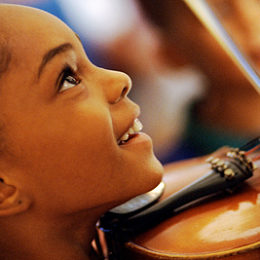Benefits of Violin for Children

There is a mystique that surrounds the violin. It is one of the most well-known stringed instruments. Children often are attracted to how sophisticated it looks to play violin. A child typically becomes fascinated between the ages of 7 to 10, although that age varies a lot.
Physical Benefits of Learning Violin for Children
A child learning the violin reaps many benefits from it. Physically, your child gains strength and flexibility in the upper body. Due to developing the skills and muscle memory needed for playing, their arms and fingers get stronger as they learn exciting and new techniques.
Your child’s posture generally improves, due to strengthening his back, shoulders, and upper arms. His back will get stronger, because of the need to sit up straight while playing. His shoulders and upper arms bear the extra weight of the instrument and its bow, as well as the weight of his own arms!
Her little fingers will gain strength, as well, on both hands. The left hand’s fingers will gain nimbleness, also, because quick movements as it presses down the strings of the violin. Finally, her right hand will learn to control the bow and coordinate its movements with the left hand.
So, there is some physical strain related to your child learning to play the violin. Especially at first, she will experience tired arms, shoulders, and back. Your child’s teacher should be able to show the child some stretches they can perform every so often to loosen tense and sore muscles that result from playing violin.
How your Child’s Mind Benefits from Learning Violin
A study at the Institute for Music and the Mind at McMaster University in West Hamilton concluded that playing violin tends to improve children’s concentration. Essentially, when a youngster plays an instrument, changes tend to occur in your child’s mind and brain:
- Improved attention span and focus
- Your child must focus on learning both the violin itself and how to read music
- Sharpened memory
- She will need to memorize both physical movements to make music, as well as how to read music
- Improved self-discipline
- To have the violin sound right, your child will need to practice certain skills over and over
The largest amount of changes brought about by musical training, that study also found, is between the ages of 10 and 13. However, children younger than 10 and older than 13 certainly reap similar benefits as well!
Learning music in general helps children with their general communication skills as well, another study concluded. Young musicians who have taken three or more years of musical training tend to show improvements in “verbal ability and visual pattern completion”.
And in yet another study, published in the Psychology of Music, the authors tracked two groups of children in second grade over the course of three years. One group was given regular piano lessons over the course of the three years, the other group was given no music lessons at all as a control for the study. At the end of the three years, a standard test was given to both groups to asses their “significantly better vocabulary and verbal sequencing scores than did the non-music-learning control group” knowledge. These scores showed an improvement in skills that are fundamental to children acquiring and improving their reading skills.
Social Benefits for Children
There are other benefits that are clear, even without quoting scientific studies. Playing the violin gives your child something to talk to others about! They have the opportunity to proudly talk about their new skills to relatives and friends. Imagine attending a concert in which your child (or niece, nephew, cousin, et cetera) is performing!
If he or she is an introvert, playing the violin can give them the opportunity to play in an orchestra with others and improve her social interaction. S/he can learn responsibility by helping other budding violinists in her class or group to learn the music. She can gain self-discipline through practicing the chosen instrument…perhaps even playing a violin solo eventually!
If your child wants to play simply for the pleasure of playing, rather than socially, it still gives her an area in her life where she has some control. Some of my best memories of learning to play the violin are from when I recorded one half of a duet (a piece of music wherein two players play the same piece but different notes) and then played the other half of the duet with the recording. I didn’t realize it at the time, but this was a great way to spice up my practice routine!
Or, if your child is an extrovert, violin can give children a chance to spend some time focusing and concentrating on the skills necessary to improve their playing. He will be improving concentration, memory, self-discipline and more with practice.
For your child, you’ll need to be sure not to make practicing violin a chore like washing dishes however. Every parent should strive to avoid becoming a “stage mom” (or dad) who insists on their child practicing and playing so much that the child burns out on the instrument. You want your child to have fun with the magic of music!
Finally, maintaining and caring for an instrument will give your child a sense of responsibility. While the classic tactic is to give a child a puppy to “teach them responsibility”, an instrument requires almost as much care. The instrument must be tuned, cleaned, taken out of the case at the beginning of playing sessions, put back into the case at the end of playing sessions, and more!
– Kate Marie, violin teacher
www.learninghowtoplaytheviolin.com



